It has always been assumed by the general public and by past leadership research that men make better leaders than women. How else do you account for the dominance of men in important leadership positions in the U.S.? The stereotypic leader has frequently been described in distinctively male characteristics, whereas characteristics such as compassion, kindness, non-judgment and empathy—associated with women—have been viewed as weaknesses.
The Status of Women in Leadership
In an article I wrote in the Financial Post in May, 2010, entitled “What’s Happened to the Glass Ceiling,” I said, “Call it a glass ceiling, glass wall or a glass floor—there is still a barrier blocking senior women leaders in organizations. High-powered executive and professional women are increasingly opting out of, being bypassed, or otherwise disappearing from the professional workforce. While this exists, true diversity in organizations will not happen.”
There still is considerable gender bias when it comes to considering women as leaders. Harvard’s global online research study, which included over 200,000 participants, showed that 76% of people (men and women) are gender-biased and tend to think of men as better suited for careers and women as better suited as homemakers.
The World Economic Forum’s report called the Global Gender Gap Index, which has been used since 2006 as a tool to capture gender-based disparities, by measuring national gender gaps in economic, political, health and educational metrics on the best countries for women in economic equality terms, place the Scandinavian countries and New Zealand at the top, with Canada rated at 16thand the U.S. at 49th.
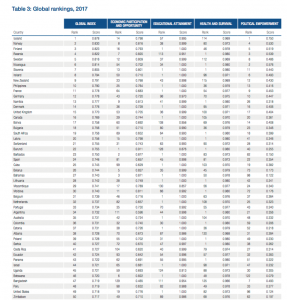
A 2017 Grant Thornton International Business Reportfound that women now hold 25% of senior management positions globally. The proportion of senior leadership roles held by women has moved by just one percent in 12 months from 24% in 2016 to 25% in 2017 – and four percent in the last five years. Moreover, the percentage of businesses with no women in senior leadership has risen at the same rate – from 33% in 2016 to 34% in 2017 – with no improvement since 2012. In North America 23% of senior roles are held by women; 31% of businesses have no women in senior roles. The US has seen no movement in the past year, with the proportion of senior roles held by women still at 23% and the percentage of businesses without women in top positions remaining at 31%.
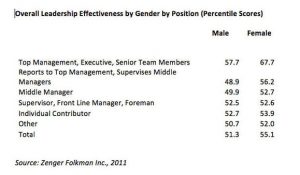
The U.S. in particular is taking steps backwards with respect to gender equality. In the field of law, women are more than 50% of the law students, but less than 25% of law firm partners, federal judges, and law school deans. In 2012, women are expected to earn 63% of master’s degrees and 54% of doctoral and professional degrees, but comprise only 20% of full university professors and only 25% of college presidents. Women comprise only 17% of the U.S. House of Representatives, 16% of the U.S. Senate, 16% of state governors and 24% of all state legislators. Internationally, the U.S. ranks 85th in the world in its share of women in national legislative bodies. Of the largest 100 cities in the U.S., only 9% have female mayors. A recent Catalyst Corporation report showed that women held only 16% of Board of Directors seats at large companies, and more than 25% of Fortune 500 companies had no female executive officers.
Even in the movie industry the picture is the same. In 2011, men directed 95% of the top-grossing films, an increase since 1998. Only 4 women have been nominated for Oscars as best director and only one has won. Eighty-four percent of the 2011 Oscar nominations for screenwriting went to men. Seventy percent of movies starred men, not women. And finally 77% of all Oscars went to men. While the situation has improved in the last two years, parity is still far away.
In the U.S., the recent divisive and acrimonious political campaigns have unearthed attempts to actually move women’s rights and diversity backwards. A record number of state legislative bills and several in Congress are designed to roll back women’s reproductive rights. So too, has proposed substantial pay equity legislation been held up in Congress. An ABC News/Washington Post reported recently that one in four American women have been sexually harassed on the job, yet only 64% of Americans see harassment as a serious workplace problem, down from 88% in 1992. Yet full pay equity would produce a significant stimulus to the consumer-based economy, according to Heidi Hartmann, president of the Institute for Women’s Policy Research, who estimates that pay equity would grow the U.S. economy 3-4%, compared to the 1.5% produced by the $800 billion stimulus bailout.
Data show that men win more promotions, more challenging assignments and more access to top leaders than women do. Men are more likely than women to feel confident they are en route to an executive role, and feel more strongly that their employer rewards merit.
Women, meanwhile, perceive a steeper trek to the top. Less than half feel that promotions are awarded fairly or that the best opportunities go to the most-deserving employees. A significant share of women say that gender has been a factor in missed raises and promotions. Even more believe that their gender will make it harder for them to advance in the future—a sentiment most strongly felt by women at senior levels.
These are the conclusions of a major new study of working women conducted by LeanIn.Org and McKinsey & Co. In one of the largest studies to date on this topic, researchers gathered data on promotions, attrition and career outcomes at 132 global companies, and they surveyed 34,000 men and women at those companies on their experiences at work.
The disparity begins at entry level, where men are 30% more likely than women to be promoted to management roles. It continues throughout careers, as men move up the ladder in larger numbers and make up the lion’s share of outside hires. Though their numbers are growing slowly, women hold less than a quarter of senior leadership positions and less than one-fifth of C-suite roles.
What is the evidence to support the contention that women are better leaders?
Kellie A. McElhaney and Sanaz Mobasseri of the Haas School of Business at the University of California, Berkley, produced a report, “Women Create a Sustainable Future.”Among the conclusions in their research and published in the report, was “companies that explicitly place value on gender diversity perform better in general, and perform better than their peers on the multiple dimensions of corporate sustainability.”
A 2012 Dow Jones study shows that business startups are more likely to succeed if they have women on their executive team. And according to the Center for Women’s Business Research, although women own about 40% of the private businesses in the U.S., women make up less than 10% of venture-backed start-ups.
A 2005 Report on Women and Entrepreneurship, the percentage of entrepreneurs who expect growth for the businesses is higher for female entrepreneurs than male entrepreneurs. And according to a separate study by Babson College and the London School of Economics, women led start-ups experienced fewer failures in moving from early to growth–stage companies than men.
Catalyst, the U.S. non-profit company, found that in 2011 a 26% difference in return on invested capital (ROIC) between the top-quartile companies with 19-44% women board representation and the bottom quartile companies with zero women directors. When the McKinsey team asked business executives globally what they believe the most important leadership attributes are for success today, each of the top four—intellectual stimulation, inspiration, participatory decision-making and setting expectations/rewards—were more commonly found among women leaders. McKinsey reported in its Organizational Health Index(OHI)companies with three or more women in top positions scored higher than their peers.
A Pew Center Global Attitudes Project found that 75% of respondents in the U.S. and 80% in Canada believe that women make equally good political leaders, and the numbers were much higher and Europe, Asia and parts of South America. Another Pew Center study, Social and Demographic Survey found women leaders possessed more leadership traits of honesty, intelligence, compassion and creativity than men, whereas men scored higher only in decisiveness.
Jack Zenger and Joseph Folkman, authors of The Inspiring Leader: Unlocking the Secrets of How Extraordinary Leaders Activate, writing in the Harvard Business Review Blog Network, argue that in today’s complex demanding world of organizations, women may possess superior leadership capabilities compared to men.
Zenger and Folkman make that contention based on 30 years of research on what constitutes overall leadership effectiveness that comes from 360 evaluations of a leader’s peers, bosses and direct reports and a 2011 survey of over 7,000 leaders from some of the most successful and progressive organizations. They concluded “at every level, more women were rated by their peers, their bosses, their direct reports, and their other associates as better overall leaders than their male counterparts—and the higher the level, the wider the gap grows.” Specifically, the authors note, “at all levels, women were rated higher in fully 12 or the 16 competencies that go into outstanding leadership. And two of the traits where women outscored men to the highest degree—taking initiative and driving for results—have long been thought of as particularly male strengths.” Men outscored women significantly on only one management competency—the ability to develop a strategic perspective.In fact, at every level, more women were rated by their peers, their bosses, their direct reports, and their other associates as better overall leaders than their male counterparts — and the higher the level, the wider that gap grows.
Research by Zenger and Folkman from 2011 (updated in 2019) clearly shows that women are more effective on most of the top competencies of good leadership – including taking initiative, inspiring and motivating others, and building relationships.
But interestingly these differentials are not constant. Everyone changes over their careers and develops capability. By looking at the ages of those in the study it’s possible to track the differences between men and women in terms of their leadership capability at different stages in their careers.
When they’re 20-year-olds both men and women have the same level of leadership effectiveness. However, by about 25 men are more effective than women. But from that point on women develop and catch up, and by age 40 they are on par with men. After that they become increasingly more effective than men to a peak of around 9% more effective at 60. After this the differential declines.
This pattern reflects what I have seen: young men strongly pushing ahead in their careers initially and, in general, women taking more time to quietly build their capability and confidence. At about 40 women’s experience and confidence have got to the levels where they can be used as effectively as men use theirs.
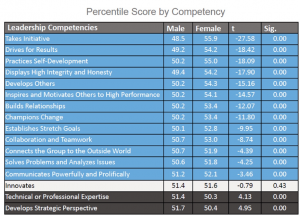
In an update to Zenger Folkman‘s 2012 survey data published in the Harvard Business Review, company president Joe Folkman provided CNBC Make It the results of the company’s latest survey.

A new study, led by Professor Øyvind L. Martinsen, head of Leadership and Organisational Behaviour at the BI Norwegian Business School, assessed the personality and characteristics of nearly 3,000 managers and has concluded that women are better suited to leadership than men.
In the study, women outperformed men in four of the five categories studied: initiative and clear communication; openness and ability to innovate; sociability and supportiveness; and methodical management and goal-setting.
“Businesses must always seek to attract customers and clients and to increase productivity and profits. Our results indicate that women naturally rank higher, in general, than men in their abilities to innovate and lead with clarity and impact,’” said Professor Martinsen.
“These findings pose a legitimate question about the construction of management hierarchy and the current dispensation of women in these roles.”
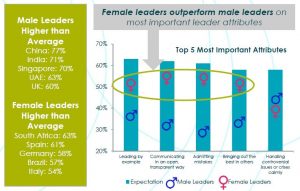
Thomas Malone, a management professor at MIT and his colleagues completed research which tried to determine what made a team smarter. He created teams of people aged 18 to 60, had them take IQ tests and then gave them a series of problems to solve. He found that those with the highest IQs did not perform the best, but the teams with the most women did. He reported in the Harvard Business Review, “the standard argument is that diversity is good and you should have both men and women in a group…But so far, the data show, the more women, the better.”
Tony Schwartz, writing in the Harvard Business Review Blog Networkdescribes what women know about leadership than men don’t, arguing “An effective modern leader requires a blend of intellectual qualities—the ability to think analytically, strategically and creatively—and emotional ones, including self-awareness, empathy and humility…I meet far more women with this blend of qualities than I do men.” He goes on to say “The vast majority of CEOs and senior executives I’ve met over the past decade are men [who] resist introspection, feel more comfortable measuring outcomes than they do managing emotions, and under-appreciate the powerful connection between how people feel and how they perform…For the most part, women, more than men, bring to leadership a more complete range of the qualities modern leaders need, including self-awareness, emotional attunement and authenticity.” Schwartz contends that men overvalue their strengths from an early age, while women tend to undervalue theirs, and that men are often victims of their own egos, and their need to win and use power.
The top scholar on gender and leadership, Dr. Alice Eagly, recently stated that her studies show that women are more likely than men to possess the leadership qualities that are associated with success. That is, women are more transformational than men – they care more about developing their followers, they listen to them and stimulate them to think “outside the box,” they are more inspirational, AND they are more ethical. Dr. Bernard Bass, who developed the current theory of transformational leadership, predicts that in the future women leaders will dominate simply because they are better suited to 21st century leadership/management than are men.
A recent Gallup Poll found that when it comes to bosses, Americans no longer prefer a man over a woman.
In 2014, a study published in the Journal of Applied Psychology analyzed the findings of 99 different studies from 1962–2011 in order to discover nuances within leadership in relation to the gender divide. Predictably, the results suggested that environment played a key role in determining each gender’s general effectiveness in leadership. In male-dominated areas such as military or government, male leaders were viewed to make better leaders than women. Conversely, women were seen as most effective in areas such as social services and education – they also came out on top in the sweeping term “business”.
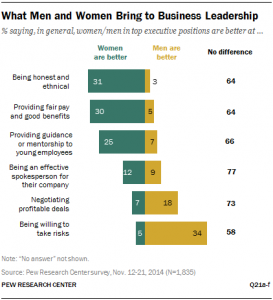
In a New York Timesarticle, Sheryl Sandberg and Adam Grant wrote that, “Start-ups led by women are more likely to succeed; innovative firms with more women in top management are more profitable; and companies with more gender diversity have more revenue, customers, market share and profits.” From the same article, Sandberg and Grant reveal that, when male executives speak up, their competency scores rise by 10%. When women executives speak up, their ratings among peers plummet by 14%.
Numerous studies show that boards with more women perform better, with the frequently cited 2015 report by McKinsey & Co underscoring the fact that businesses in the top quartile for gender diversity are 15 per cent more likely to have financial returns above their national industry average.
However, just having a female CEO or a high number of women employees is not enough, says another study, this time of over 22,000 companies across 91 countries. The Peterson-EYstudy reveals that profitable companies include women across top management, who inevitably create a gender-diverse pipeline.
According to a study conducted by Chris Bart, professor of strategic management at the DeGroote School of Business at McMaster University, and Gregory McQueen, a McMaster graduate and senior executive associate dean at Still University’s School of Osteopathic Medicine, women actually run better performing businesses than men.
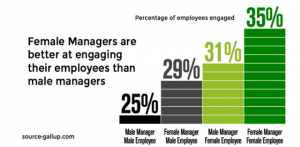
“Women are knocking on the door of leadership at the very moment when their talents are especially well matched with the requirements of the day,” writes David Gergen in the introduction to Enlightened Power: How Women Are Transforming the Practice of Leadership. What are these talents? Once it was thought that leaders should be aggressive and competitive, and that men are naturally more of both. But psychological research has complicated this picture. In lab studies that simulate negotiations, men and women are just about equally assertive and competitive, with slight variations. Men tend to assert themselves in a controlling manner, while women tend to take into account the rights of others, but both styles are equally effective, write the psychologists Alice Eagly and Linda Carli, in their 2007 book, Through the Labyrinth.
A 2008 study attempted to quantify the effect of this more-feminine management style. Researchers at Columbia Business School and the University of Maryland analyzed data on the top 1,500 U.S. companies from 1992 to 2006 to determine the relationship between firm performance and female participation in senior management. Firms that had women in top positions performed better, and this was especially true if the firm pursued what the researchers called an “innovation intensive strategy,” in which, they argued, “creativity and collaboration may be especially important”—an apt description of the future economy.
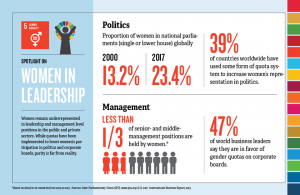
Women now earn 60 percent of master’s degrees, about half of all law and medical degrees, and 42 percent of all M.B.A.s. Most important, women earn almost 60 percent of all bachelor’s degrees—the minimum requirement, in most cases, for an affluent life. In a stark reversal since the 1970s, men are now more likely than women to hold only a high-school diploma. “One would think that if men were acting in a rational way, they would be getting the education they need to get along out there,” says Tom Mortenson, a senior scholar at the Pell Institute for the Study of Opportunity in Higher Education. “But they are just failing to adapt.”
So what action needs to be taken?
According to the Catalyst research organization, since 2008, at least 9 countries, including France, Norway, Italy and Spain, have passed legislation requiring some kind of quota requirements for diversity on corporate boards. Other countries, including the U.S., Britain, Australia and Germany have adopted regulations requiring organizations to review board diversity at their annual meetings. Canada at this point lags far behind in these initiatives, with no legislative actions or regulations. In October, 2012, the European Commission proposed a new law that would enforce quotes of 40% for women’s representation on European corporate boards by 2020.
Joanna Barsh and Lareina Yee, of McKinsey & Company, and authors of a special report for The Wall Street Journal Executive Task Force for Women in the Economy, argue “As the U.S. struggles to sustain historic GDP growth rates, it is critically important to bring more women into the workforce and fully deploy high-skill women to drive productivity improvement.” The authors reviewed over 100 exiting research papers, surveyed 2,500 men and women and interviewed 30 chief diversity officers and experts to determine why there were such low numbers of women leaders in organizations, particularly at the upper levels. Of all the factors that were examined, the authors identified entrenched beliefs as one of the most significant—the prevailing belief that women were not as capable as men to be leaders. Barsh and Yee of McKinsey contend “if companies could raise the number of middle management women who make it to the next level by 25%, it would significantly alter the shape of the leadership talent pipeline.”
Avivah Wittenberg-Cox, writing in the Harvard Business Review Blog Network, commenting on changing corporate culture, “leaders need to tell the majority of men in corporate life that they also need to change, and allow new and different styles of leadership to move in—and up.”
Society Has Changed
What if the modern, postindustrial economy is simply more congenial to women than to men? For a long time, evolutionary psychologists have claimed that we are all imprinted with adaptive imperatives from a distant past: men are faster and stronger and hardwired to fight for scarce resources, and that shows up now as a drive to win on Wall Street; women are programmed to find good providers and to care for their offspring, and that is manifested in more- nurturing and more-flexible behavior, ordaining them to domesticity. This kind of thinking frames our sense of the natural order. But what if men and women were fulfilling not biological imperatives but social roles, based on what was more efficient throughout a long era of human history? What if that era has now come to an end? More to the point, what if the economics of the new era are better suited to women?
The postindustrial economy is indifferent to men’s size and strength. The attributes that are most valuable today—social intelligence, open communication, the ability to sit still and focus—are, at a minimum, not predominantly male. In fact, the opposite may be true. Women in poor parts of India are learning English faster than men to meet the demands of new global call centers. Women own more than 40 percent of private businesses in China, where a red Ferrari is the new status symbol for female entrepreneurs. Last year, Iceland elected Prime Minister Johanna Sigurdardottir, the world’s first openly lesbian head of state, who campaigned explicitly against the male elite she claimed had destroyed the nation’s banking system, and who vowed to end the “age of testosterone.”
This is the first time that the cohort of Americans ages 30 to 44 has more college-educated women than college-educated men, and the effects are upsetting the traditional Cleaver-family dynamics. In 1970, women contributed 2 to 6 percent of the family income. Now the typical working wife brings home 42.2 percent, and four in 10 mothers—many of them single mothers—are the primary breadwinners in their families. The whole question of whether mothers should work is moot, argues Heather Boushey of the Center for American Progress, “because they just do. This idealized family—he works, she stays home—hardly exists anymore.”
The general public’s—and indeed even leadership experts—views on what constitutes good leaders has not substantially changed, and a 20thcentury stereotype of leaders is persistent, despite research evidence to the contrary. The countries that adapt to the new order the fastest; and recognize the value and need for women in leadership may be the ones that most successfully navigate the balance of the 21stcentury.
Copyright: Neither this article or a portion thereof may be reproduced in any print or media format without the express permission of the author.
Read my latest book: Eye of the Storm: How Mindful Leaders Can Transform Chaotic Workplaces, available in paperback and Kindle on Amazon and Barnes & Noble in the U.S., Canada, Europe and Australia and Asia.


